Storage Solutions and Virtualization Techniques for Large Data Files
VerifiedAdded on 2023/05/30
|6
|748
|90
AI Summary
This paper discusses the storage solutions for large data files and the comparison between container-based and machine-based virtualization techniques. It also explores the relationship between Linux container services and Windows platforms.
Contribute Materials
Your contribution can guide someone’s learning journey. Share your
documents today.
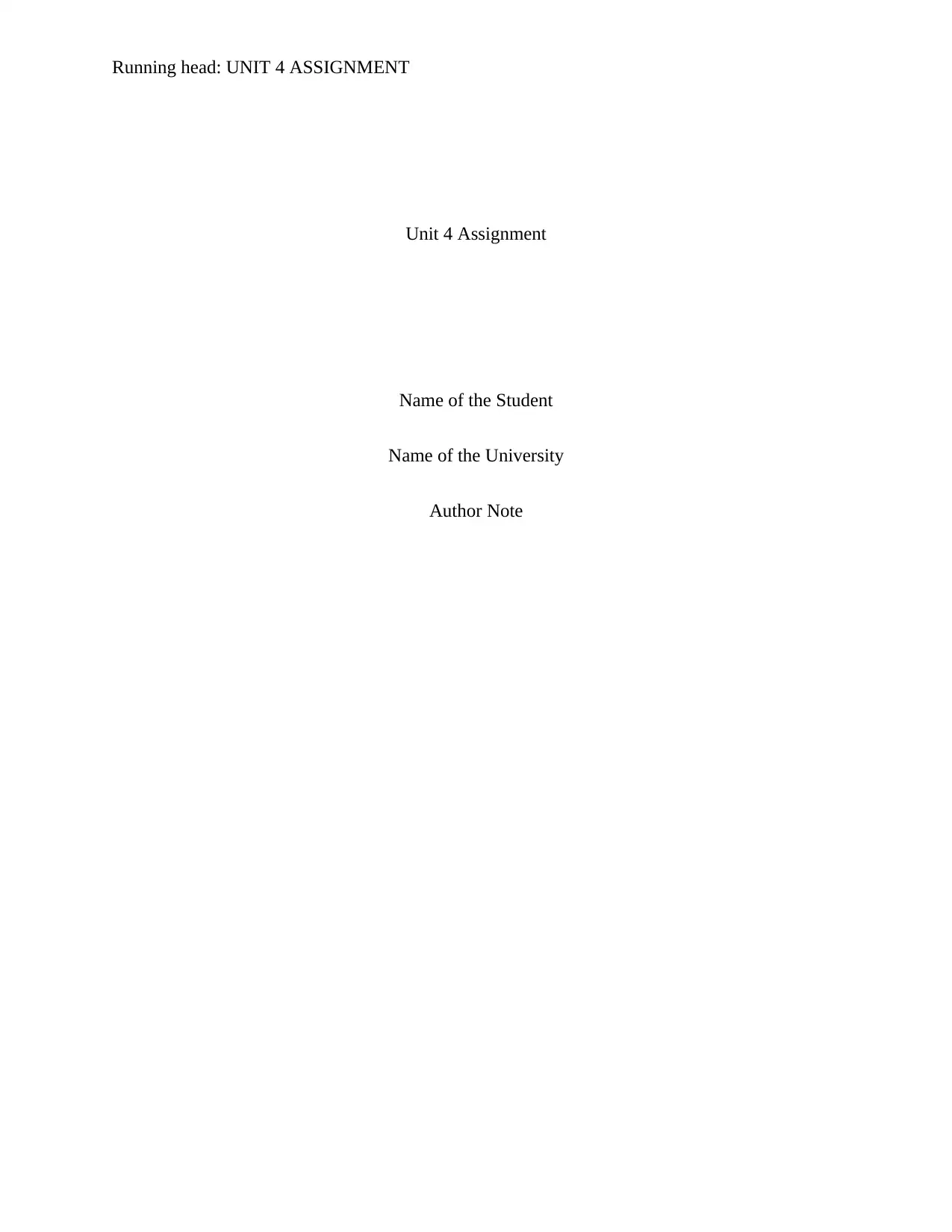
Running head: UNIT 4 ASSIGNMENT
Unit 4 Assignment
Name of the Student
Name of the University
Author Note
Unit 4 Assignment
Name of the Student
Name of the University
Author Note
Secure Best Marks with AI Grader
Need help grading? Try our AI Grader for instant feedback on your assignments.
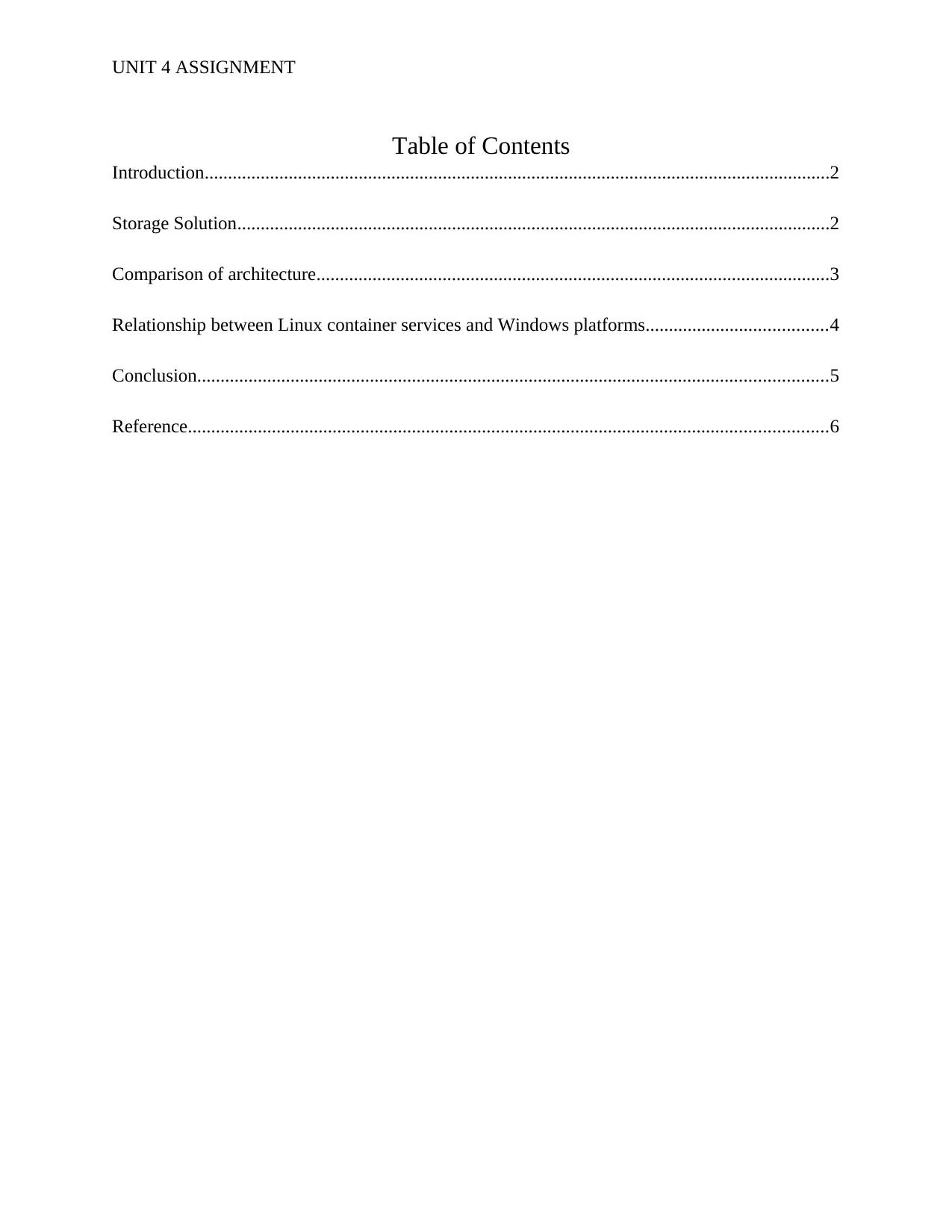
UNIT 4 ASSIGNMENT
Table of Contents
Introduction......................................................................................................................................2
Storage Solution...............................................................................................................................2
Comparison of architecture..............................................................................................................3
Relationship between Linux container services and Windows platforms.......................................4
Conclusion.......................................................................................................................................5
Reference.........................................................................................................................................6
Table of Contents
Introduction......................................................................................................................................2
Storage Solution...............................................................................................................................2
Comparison of architecture..............................................................................................................3
Relationship between Linux container services and Windows platforms.......................................4
Conclusion.......................................................................................................................................5
Reference.........................................................................................................................................6
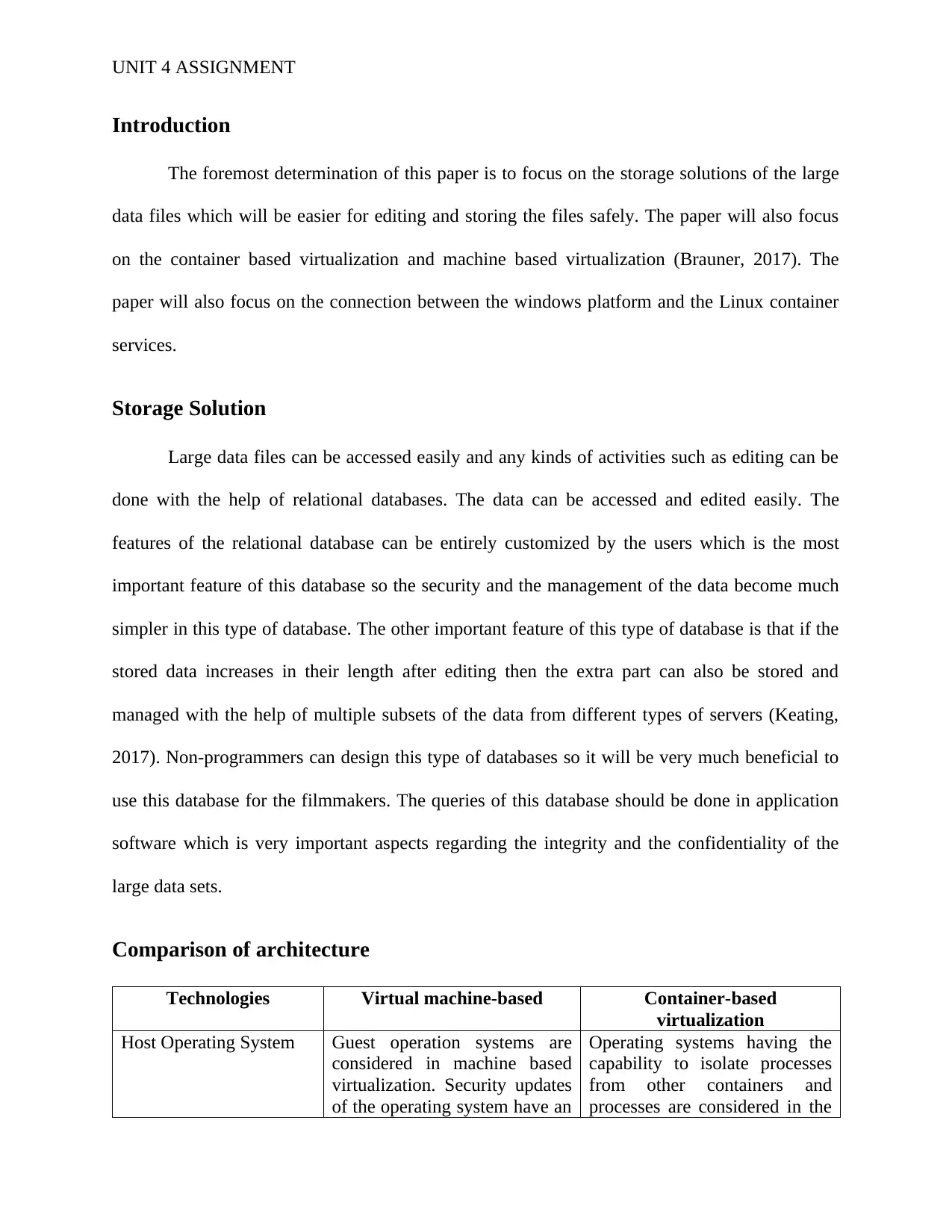
UNIT 4 ASSIGNMENT
Introduction
The foremost determination of this paper is to focus on the storage solutions of the large
data files which will be easier for editing and storing the files safely. The paper will also focus
on the container based virtualization and machine based virtualization (Brauner, 2017). The
paper will also focus on the connection between the windows platform and the Linux container
services.
Storage Solution
Large data files can be accessed easily and any kinds of activities such as editing can be
done with the help of relational databases. The data can be accessed and edited easily. The
features of the relational database can be entirely customized by the users which is the most
important feature of this database so the security and the management of the data become much
simpler in this type of database. The other important feature of this type of database is that if the
stored data increases in their length after editing then the extra part can also be stored and
managed with the help of multiple subsets of the data from different types of servers (Keating,
2017). Non-programmers can design this type of databases so it will be very much beneficial to
use this database for the filmmakers. The queries of this database should be done in application
software which is very important aspects regarding the integrity and the confidentiality of the
large data sets.
Comparison of architecture
Technologies Virtual machine-based Container-based
virtualization
Host Operating System Guest operation systems are
considered in machine based
virtualization. Security updates
of the operating system have an
Operating systems having the
capability to isolate processes
from other containers and
processes are considered in the
Introduction
The foremost determination of this paper is to focus on the storage solutions of the large
data files which will be easier for editing and storing the files safely. The paper will also focus
on the container based virtualization and machine based virtualization (Brauner, 2017). The
paper will also focus on the connection between the windows platform and the Linux container
services.
Storage Solution
Large data files can be accessed easily and any kinds of activities such as editing can be
done with the help of relational databases. The data can be accessed and edited easily. The
features of the relational database can be entirely customized by the users which is the most
important feature of this database so the security and the management of the data become much
simpler in this type of database. The other important feature of this type of database is that if the
stored data increases in their length after editing then the extra part can also be stored and
managed with the help of multiple subsets of the data from different types of servers (Keating,
2017). Non-programmers can design this type of databases so it will be very much beneficial to
use this database for the filmmakers. The queries of this database should be done in application
software which is very important aspects regarding the integrity and the confidentiality of the
large data sets.
Comparison of architecture
Technologies Virtual machine-based Container-based
virtualization
Host Operating System Guest operation systems are
considered in machine based
virtualization. Security updates
of the operating system have an
Operating systems having the
capability to isolate processes
from other containers and
processes are considered in the
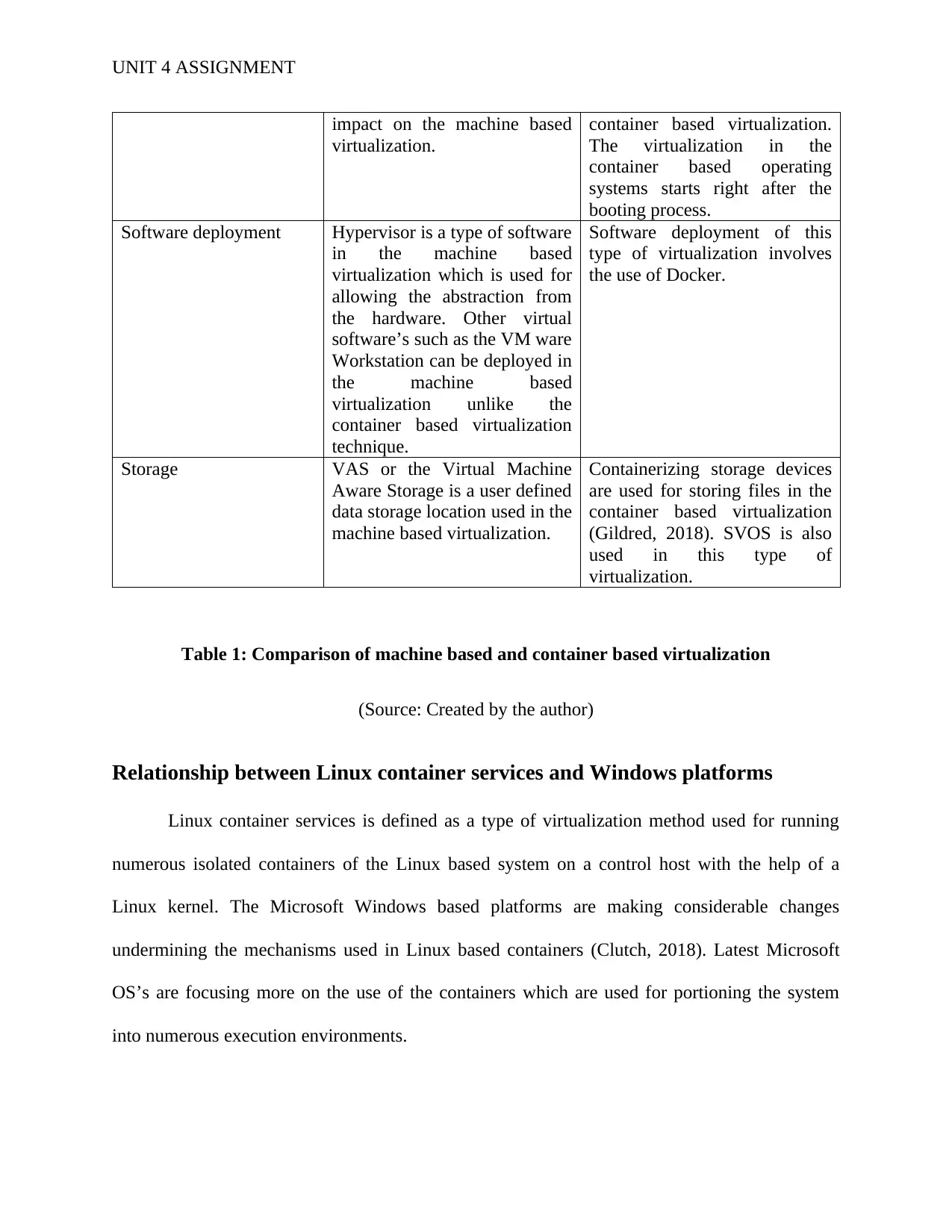
UNIT 4 ASSIGNMENT
impact on the machine based
virtualization.
container based virtualization.
The virtualization in the
container based operating
systems starts right after the
booting process.
Software deployment Hypervisor is a type of software
in the machine based
virtualization which is used for
allowing the abstraction from
the hardware. Other virtual
software’s such as the VM ware
Workstation can be deployed in
the machine based
virtualization unlike the
container based virtualization
technique.
Software deployment of this
type of virtualization involves
the use of Docker.
Storage VAS or the Virtual Machine
Aware Storage is a user defined
data storage location used in the
machine based virtualization.
Containerizing storage devices
are used for storing files in the
container based virtualization
(Gildred, 2018). SVOS is also
used in this type of
virtualization.
Table 1: Comparison of machine based and container based virtualization
(Source: Created by the author)
Relationship between Linux container services and Windows platforms
Linux container services is defined as a type of virtualization method used for running
numerous isolated containers of the Linux based system on a control host with the help of a
Linux kernel. The Microsoft Windows based platforms are making considerable changes
undermining the mechanisms used in Linux based containers (Clutch, 2018). Latest Microsoft
OS’s are focusing more on the use of the containers which are used for portioning the system
into numerous execution environments.
impact on the machine based
virtualization.
container based virtualization.
The virtualization in the
container based operating
systems starts right after the
booting process.
Software deployment Hypervisor is a type of software
in the machine based
virtualization which is used for
allowing the abstraction from
the hardware. Other virtual
software’s such as the VM ware
Workstation can be deployed in
the machine based
virtualization unlike the
container based virtualization
technique.
Software deployment of this
type of virtualization involves
the use of Docker.
Storage VAS or the Virtual Machine
Aware Storage is a user defined
data storage location used in the
machine based virtualization.
Containerizing storage devices
are used for storing files in the
container based virtualization
(Gildred, 2018). SVOS is also
used in this type of
virtualization.
Table 1: Comparison of machine based and container based virtualization
(Source: Created by the author)
Relationship between Linux container services and Windows platforms
Linux container services is defined as a type of virtualization method used for running
numerous isolated containers of the Linux based system on a control host with the help of a
Linux kernel. The Microsoft Windows based platforms are making considerable changes
undermining the mechanisms used in Linux based containers (Clutch, 2018). Latest Microsoft
OS’s are focusing more on the use of the containers which are used for portioning the system
into numerous execution environments.
Secure Best Marks with AI Grader
Need help grading? Try our AI Grader for instant feedback on your assignments.
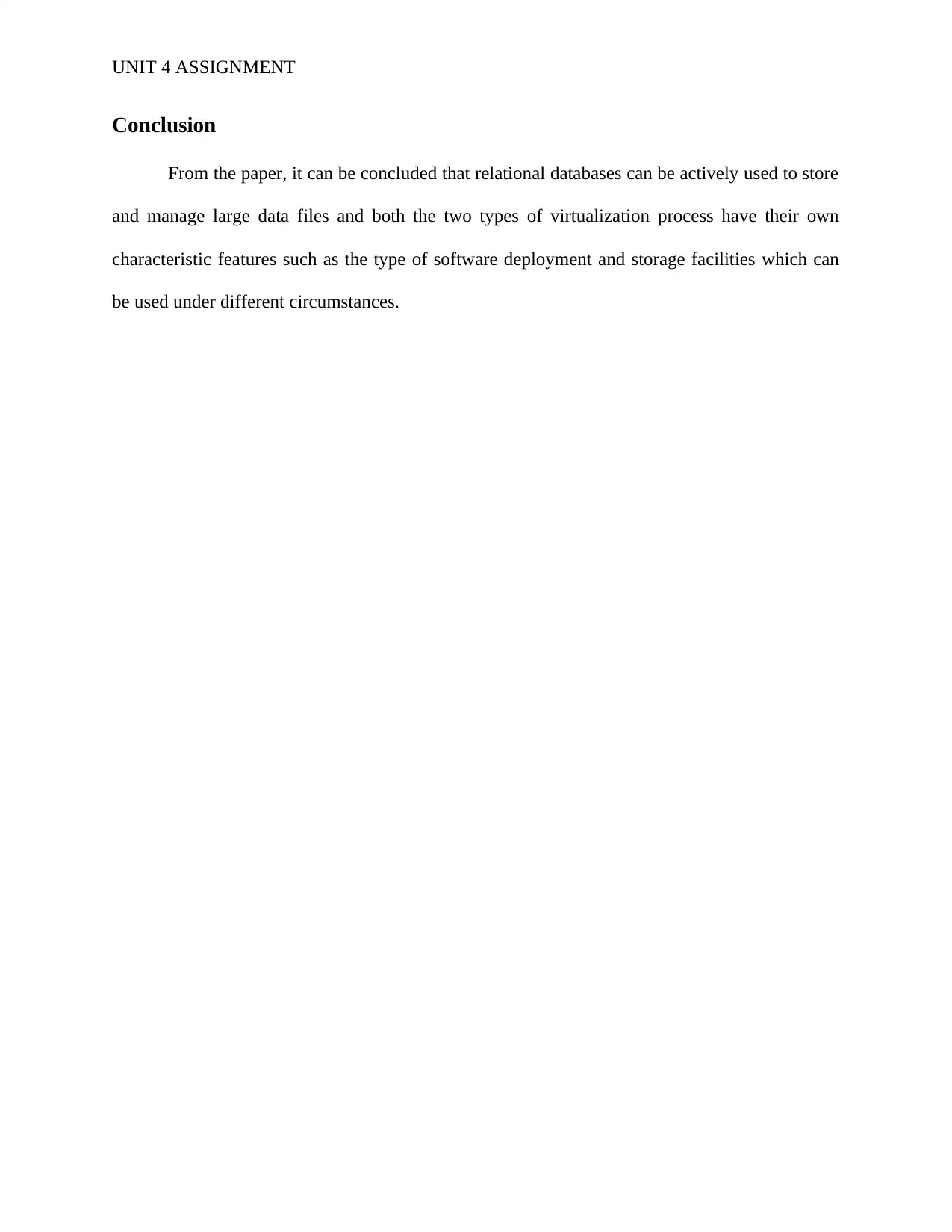
UNIT 4 ASSIGNMENT
Conclusion
From the paper, it can be concluded that relational databases can be actively used to store
and manage large data files and both the two types of virtualization process have their own
characteristic features such as the type of software deployment and storage facilities which can
be used under different circumstances.
Conclusion
From the paper, it can be concluded that relational databases can be actively used to store
and manage large data files and both the two types of virtualization process have their own
characteristic features such as the type of software deployment and storage facilities which can
be used under different circumstances.
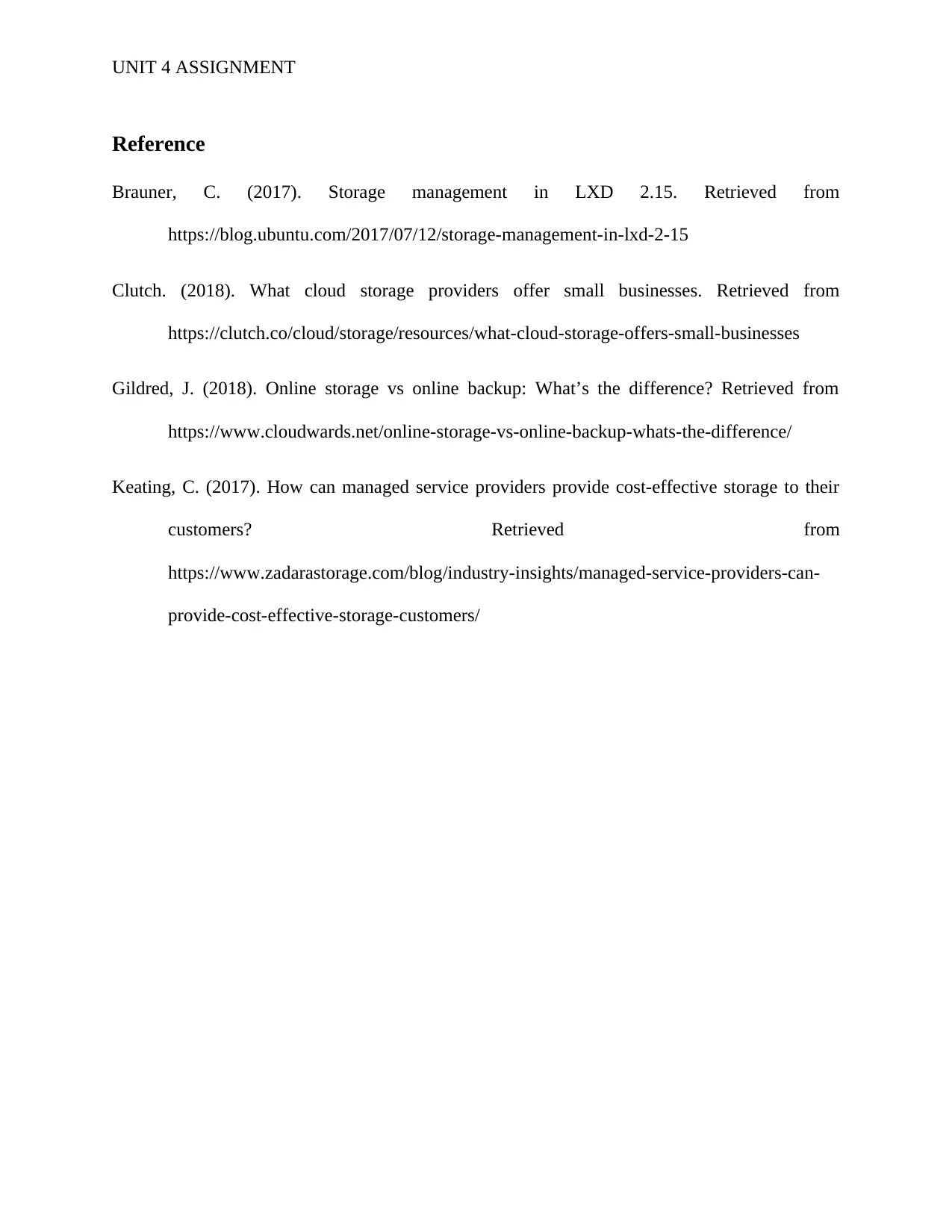
UNIT 4 ASSIGNMENT
Reference
Brauner, C. (2017). Storage management in LXD 2.15. Retrieved from
https://blog.ubuntu.com/2017/07/12/storage-management-in-lxd-2-15
Clutch. (2018). What cloud storage providers offer small businesses. Retrieved from
https://clutch.co/cloud/storage/resources/what-cloud-storage-offers-small-businesses
Gildred, J. (2018). Online storage vs online backup: What’s the difference? Retrieved from
https://www.cloudwards.net/online-storage-vs-online-backup-whats-the-difference/
Keating, C. (2017). How can managed service providers provide cost-effective storage to their
customers? Retrieved from
https://www.zadarastorage.com/blog/industry-insights/managed-service-providers-can-
provide-cost-effective-storage-customers/
Reference
Brauner, C. (2017). Storage management in LXD 2.15. Retrieved from
https://blog.ubuntu.com/2017/07/12/storage-management-in-lxd-2-15
Clutch. (2018). What cloud storage providers offer small businesses. Retrieved from
https://clutch.co/cloud/storage/resources/what-cloud-storage-offers-small-businesses
Gildred, J. (2018). Online storage vs online backup: What’s the difference? Retrieved from
https://www.cloudwards.net/online-storage-vs-online-backup-whats-the-difference/
Keating, C. (2017). How can managed service providers provide cost-effective storage to their
customers? Retrieved from
https://www.zadarastorage.com/blog/industry-insights/managed-service-providers-can-
provide-cost-effective-storage-customers/
1 out of 6
Related Documents
Your All-in-One AI-Powered Toolkit for Academic Success.
+13062052269
info@desklib.com
Available 24*7 on WhatsApp / Email
![[object Object]](/_next/static/media/star-bottom.7253800d.svg)
Unlock your academic potential
© 2024 | Zucol Services PVT LTD | All rights reserved.





